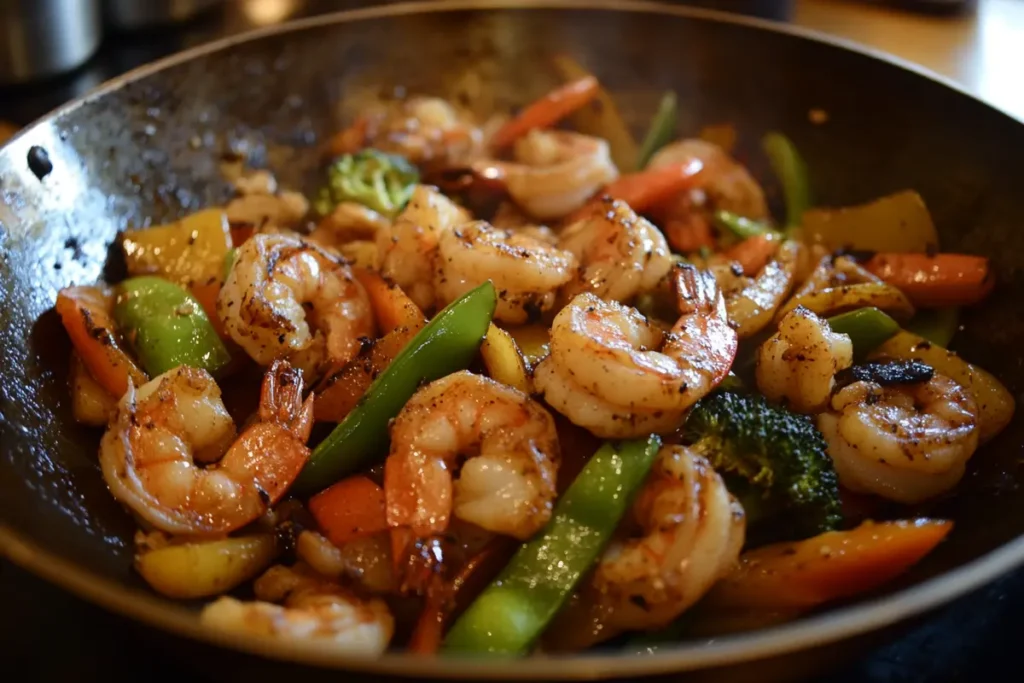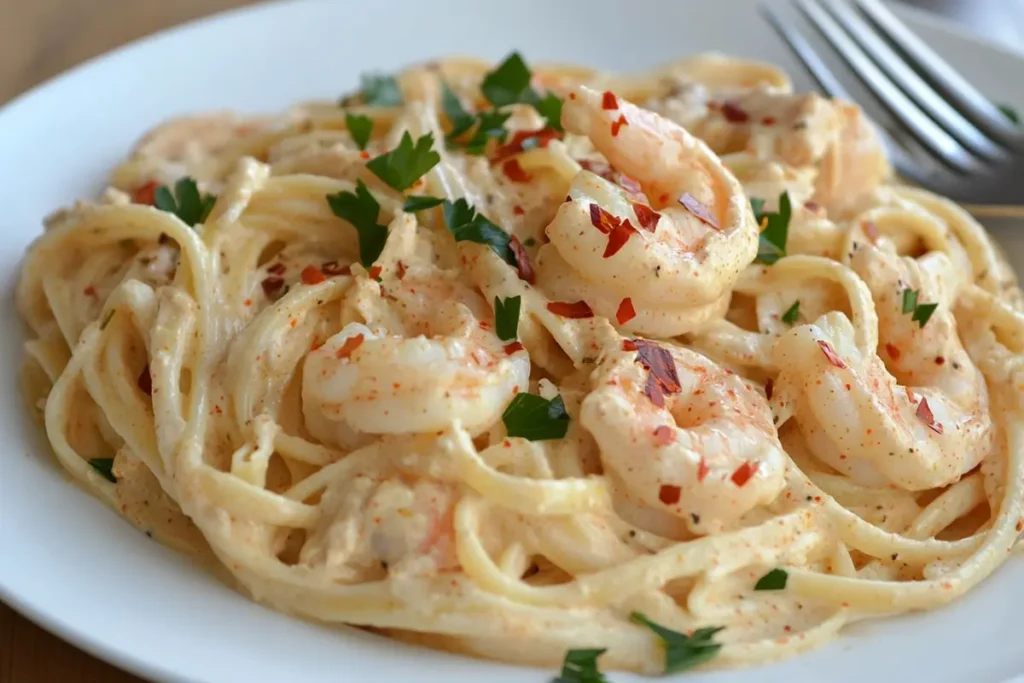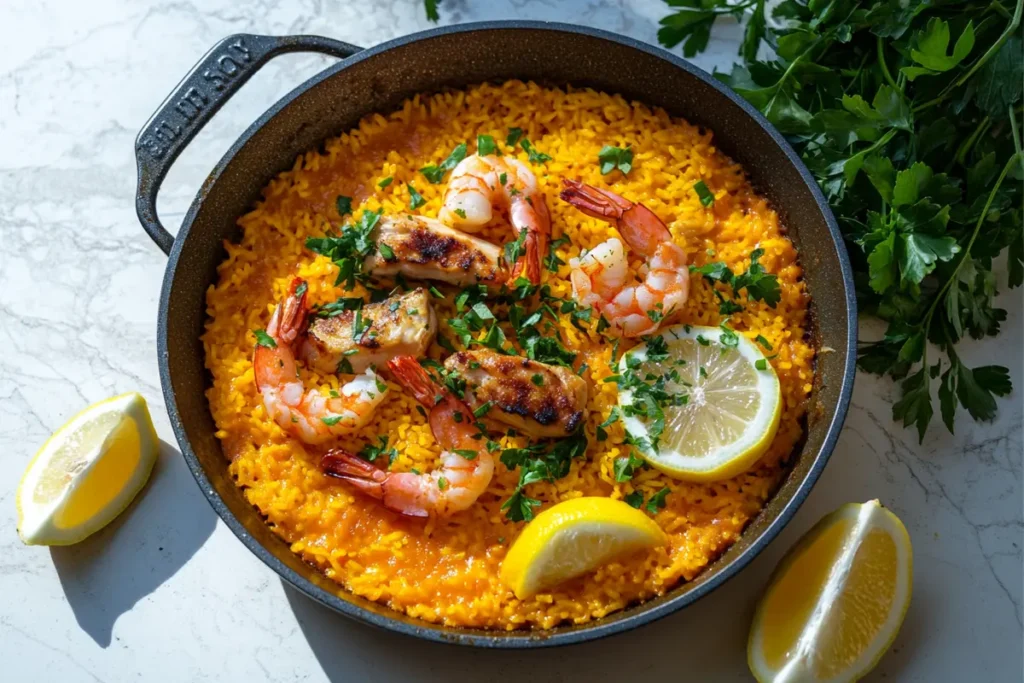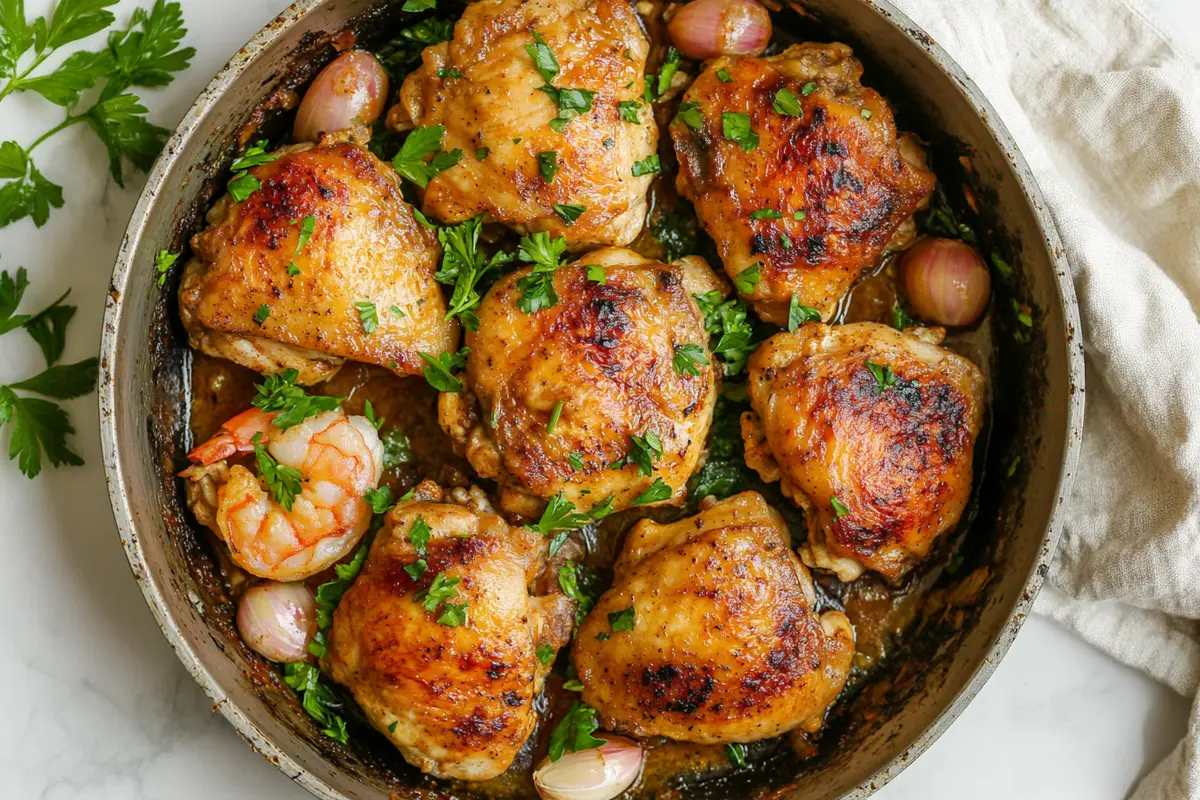Can Shrimp and Chicken Be Cooked Together?
Can shrimp and chicken be cooked together?” Absolutely! Cooking shrimp and chicken together can yield flavorful results, but the process isn’t as simple as tossing everything into a pan at the same time. If you’re wondering how to cook these proteins safely and effectively, it’s crucial to understand that both require different handling and cooking techniques to ensure they’re safe to eat and taste their best. Here’s why.
Why Cooking Shrimp and Chicken Together Is Possible
First, let’s address the elephant in the room: Is it safe? Absolutely! However, the key is understanding that shrimp and chicken have different cooking times and temperatures. Shrimp cooks much faster than chicken due to its delicate structure and lower density. While chicken must reach an internal temperature of 165°F (74°C) to be safe, shrimp is ready at just 145°F (63°C).
By being mindful of these differences, you can cook them together in a way that preserves their distinct textures and flavors without compromising safety.
Different Textures and Cooking Times
Can shrimp and chicken be cooked together? The answer is yes, but it takes a careful approach. Unlike chicken, which has a firm texture that requires more time to cook through, shrimp is tender and cooks in mere minutes. Cooking them simultaneously without a strategy can result in dry, overcooked shrimp or undercooked chicken—neither of which is ideal! Understanding the differences in their cooking requirements is key to successfully preparing dishes that combine these proteins.
Safety Considerations for Cooking Chicken and Shrimp
Proper handling and preparation of shrimp and chicken are non-negotiable to ensure food safety and to keep chicken moist while cooking. Proper handling and preparation of shrimp and chicken are non-negotiable to ensure food safety and to keep chicken moist while cooking. Here are some tips:
- Always thaw frozen proteins safely in the refrigerator.f
- Keep raw shrimp and chicken separate to prevent cross-contamination.
- Use separate utensils and cutting boards for raw and cooked ingredients.
When to Cook Them Together
If you’re preparing a one-pan dish, like a stir-fry or pasta, cook chicken first since it takes longer. Once the chicken is nearly done, add the shrimp to the pan, ensuring everything finishes cooking at the same time. This method ensures neither protein is over- or undercooked.
Understanding Food Safety When Cooking Shrimp and Chicken Together
Cooking shrimp and chicken together isn’t just about taste—it’s also about ensuring the meal is safe to eat. Handling and preparing these proteins correctly can make all the difference between a delightful dish and a food safety nightmare. Let’s dive into some essential tips that will keep your meals both delicious and safe.
Different Cooking Times and Temperatures
When it comes to cooking proteins, timing is everything. Shrimp, with its tender flesh, cooks incredibly fast—typically within 2-4 minutes, depending on size. Chicken, on the other hand, requires a longer cooking time to reach a safe internal temperature of 165°F (74°C).
Here’s a quick guide for handling the cooking process:
- Cook chicken first: Since chicken takes longer, start with it to ensure it reaches the proper temperature.
- Add shrimp later: Introduce shrimp toward the end of the cooking process, when the chicken is almost done. This minimizes the risk of overcooking the shrimp.
By following this simple method, you can enjoy tender, juicy chicken alongside perfectly cooked shrimp.
Avoiding Cross-Contamination
Cross-contamination can happen easily when handling raw shrimp and chicken, as both can carry harmful bacteria like Salmonella or Vibrio. To keep your kitchen safe:
- Use separate utensils and cutting boards for raw and cooked proteins.
- Wash hands frequently, especially after handling raw chicken or shrimp.
- Sanitize surfaces and tools immediately after use.
This might sound basic, but these precautions are crucial for preventing foodborne illnesses.
Best Practices for Safe Cooking
Here are some additional tips to guarantee your dish is both safe and appetizing:
- Thaw frozen proteins in the refrigerator. Avoid thawing at room temperature to prevent bacteria growth.
- Use a meat thermometer. This ensures that chicken has reached the required 165°F (74°C) and shrimp is safely cooked at 145°F (63°C).
- Don’t overcrowd the pan. Allow space for even cooking, ensuring heat circulates properly around each piece of chicken and shrimp.
Layering Ingredients for Safety
One of the best ways to cook shrimp and chicken together is by layering ingredients strategically:
- Start by searing the chicken until it’s golden brown on the outside.
- Add any vegetables or aromatics, which can soften while the chicken continues to cook.
- Introduce shrimp last, stirring frequently to ensure it cooks evenly without overcooking.
This approach ensures every ingredient is cooked perfectly, with no risk of undercooked proteins.
Methods for Cooking Shrimp and Chicken Together
Now that we’ve covered the safety essentials, let’s dive into the techniques that bring shrimp and chicken together in perfect harmony. Whether you’re working with a skillet, oven, or grill, these methods ensure both proteins shine while complementing each other’s textures and flavors.
Sequential Cooking in a Single Pan
One of the simplest ways to cook shrimp and chicken together is to use a single pan but cook them in stages. This approach works wonderfully for dishes like stir-fries, curries, or creamy pasta.
- Step 1: Heat oil in a large skillet over medium heat.
- Step 2: Add seasoned chicken pieces and cook until they’re golden brown and cooked through, usually about 6-8 minutes, depending on their size.
- Step 3: Remove the chicken and set it aside on a plate. Add shrimp to the same skillet, cooking for 2-3 minutes until they turn pink and opaque.
- Step 4: Combine the shrimp and chicken back in the pan, toss with sauces or seasonings, and serve immediately.
This method ensures each protein is cooked to its ideal temperature without sacrificing texture.
Utilizing Separate Cooking Methods
Sometimes, it’s best to cook shrimp and chicken separately, especially if their flavors need to remain distinct or if they require vastly different cooking times. Here’s an example:
- Grill chicken to achieve a smoky, charred flavor.
- Sauté shrimp in a separate pan with garlic, butter, and herbs for a quick and flavorful finish.
- Combine both proteins in the final dish, such as on a bed of rice, salad, or pasta.
This approach not only allows for more precise cooking but also provides an opportunity to layer flavors.
One-Pot Recipes
If you’re looking for convenience, one-pot recipes are a fantastic option. These dishes are designed to cook shrimp and chicken together by carefully layering ingredients for optimal results. Take a dish like paella or jambalaya:
- Begin by sautéing onions, garlic, and bell peppers in a large pot.
- Add chicken pieces and cook until browned.
- Stir in your choice of grains, like rice or quinoa, along with broth and seasonings. Allow the grains to absorb the flavors while the chicken continues to cook.
- Add shrimp in the last 5-7 minutes of cooking, allowing it to steam on top of the dish.
This method ensures all elements are infused with flavor, while still respecting the different cooking needs of shrimp and chicken.
Stir-Fry Techniques

Shrimp and chicken shine in stir-fry dishes, thanks to the high heat and quick cooking times, as seen in these chicken and shrimp recipes. Here’s how to make a delicious stir-fry with both proteins:
- Cook small pieces of chicken in a hot wok until fully cooked.
- Remove the chicken, then stir-fry vegetables like snap peas, carrots, and broccoli.
- Add shrimp to the wok and toss with vegetables until just cooked.
- Return the chicken to the wok, toss everything together with soy sauce, sesame oil, or your preferred stir-fry sauce, and serve immediately.
This technique maximizes flavor while keeping each ingredient perfectly tender and juicy.
Exploring Flavor Combinations and Recipe Ideas for Shrimp and Chicken
Combining shrimp and chicken in a dish not only provides a satisfying mix of textures but also opens up endless possibilities for bold, complementary flavors. From savory spice blends to international cuisine-inspired dishes, the options are as exciting as they are diverse. Let’s explore how to bring these proteins together in the most delicious ways.
Complementary Seasonings and Marinades
The key to making shrimp and chicken work harmoniously lies in choosing seasonings that enhance their natural flavors. Both proteins are versatile and can be paired with a variety of spices, herbs, and sauces.
- Garlic and Herbs: A classic blend of garlic, parsley, and thyme works wonderfully for light dishes like grilled shrimp and chicken.
- Citrus Marinades: Lemon, lime, and orange juice add brightness to shrimp while tenderizing chicken, making them perfect for zesty recipes.
- Spicy Rubs: Cajun seasoning, chili powder, and smoked paprika add a kick that complements the mildness of chicken and the sweetness of shrimp.
- Asian-Inspired Flavors: Soy sauce, ginger, sesame oil, and hoisin sauce bring a savory umami note to stir-fries and noodle dishes.
When marinating, consider the different absorption rates of shrimp and chicken. Shrimp requires only 15-20 minutes in a marinade, while chicken may need up to 6 hours.
Popular Dishes Combining Shrimp and Chicken
There are countless recipes that celebrate the marriage of shrimp and chicken. Here are a few crowd-pleasers:
Cajun Chicken and Shrimp Pasta

This creamy pasta dish is a showstopper, featuring tender chicken, juicy shrimp, and a rich Cajun-spiced sauce.
- Sauté chicken pieces with Cajun seasoning until golden brown.
- Add shrimp and cook until pink.
- Toss both proteins with cooked pasta, a creamy sauce made with heavy cream and Parmesan cheese, and a dash of spice for a bold finish.
Chicken and Shrimp Stir-Fry
A quick and healthy option, stir-fry combines colorful vegetables, succulent shrimp, and juicy chicken in a savory sauce.
- Stir-fry chicken first, then remove it from the pan.
- Cook vegetables like bell peppers, broccoli, and snap peas until tender-crisp.
- Add shrimp and a sauce made with soy sauce, ginger, and sesame oil.
- Return the chicken to the pan, toss everything together, and serve over rice or noodles.
Chicken and Shrimp Paella

Paella is a Spanish classic that beautifully combines chicken and seafood in a single dish.
- Sauté chicken with onions, garlic, and tomatoes in a wide, shallow pan.
- Add rice, saffron, and broth, then let it cook until the liquid is mostly absorbed.
- Place shrimp on top of the rice, cover the pan, and let the shrimp steam until cooked through.
Experimenting with Flavor Profiles
Don’t be afraid to mix and match flavors. For example:
- Try a sweet and tangy combination of honey garlic sauce on grilled shrimp and chicken skewers.
- Experiment with Mediterranean flavors like oregano, lemon, and olive oil.
- Create an Indian-inspired curry with a creamy coconut milk base, spiced with turmeric, cumin, and coriander.
By layering complementary flavors and textures, you can create a dish that’s both memorable and satisfying.
Frequently Asked Questions About Cooking Shrimp and Chicken Together
Can shrimp and chicken be cooked together? This question often raises many concerns for home cooks, especially those new to working with mixed proteins. Cooking shrimp and chicken together requires careful timing and technique to ensure safety and flavor. Below are some frequently asked questions, along with clear and practical answers to help you master the art of combining these two delicious proteins.
Is it safe to cook shrimp and chicken together?
Yes, it’s perfectly safe to cook shrimp and chicken together, provided each protein reaches its respective safe internal temperature. Chicken should always reach 165°F (74°C), while shrimp is done at 145°F (63°C). Cooking them in stages or separately ensures both proteins are fully cooked without compromising quality or safety.
How can I prevent overcooking shrimp when cooking with chicken?
Shrimp cooks much faster than chicken, so it’s best to add shrimp towards the end of the cooking process. If cooking in a single pan, start with chicken and remove it once cooked. Then, cook the shrimp in the same pan before combining the two proteins at the end.
What are some dishes that feature both shrimp and chicken?
Popular dishes include:
Cajun chicken and shrimp pasta, with creamy and spicy notes.
Stir-fried shrimp and chicken, tossed with colorful vegetables and savory sauce.
Jambalaya, a hearty one-pot meal with rice, chicken, shrimp, and sausage (optional).
Chicken and shrimp tacos, featuring zesty lime, cilantro, and avocado toppings.
Can I marinate shrimp and chicken together?
It’s not recommended to marinate shrimp and chicken together because shrimp absorbs flavors more quickly than chicken. Instead, marinate them separately to ensure optimal flavor and texture for both. If using the same marinade, separate it into two containers to avoid cross-contamination.
Nutritional Information (Per 100g of Cooked Shrimp and Chicken)
| Nutrient | Amount | % Daily Value* |
|---|---|---|
| Calories | 120 kcal | 6% |
| Protein | 22 g | 44% |
| Fat | 2 g | 3% |
| Saturated Fat | 0.5 g | 3% |
| Cholesterol | 120 mg | 40% |
| Sodium | 350 mg | 15% |
| Carbohydrates | 0 g | 0% |
| Fiber | 0 g | 0% |
| Sugars | 0 g | 0% |
| Iron | 2 mg | 10% |
| Calcium | 40 mg | 4% |
Conclusion: Bringing Shrimp and Chicken Together in Perfect Harmony
Can shrimp and chicken be cooked together?” Absolutely! Cooking shrimp and chicken together is not only safe but also a delightful way to create dishes bursting with flavor and texture. By understanding their unique cooking needs—like shrimp’s quick cook time and chicken’s higher safe temperature—you can easily answer the question and prepare meals that highlight the best of both proteins.
Whether you’re crafting a rich Cajun pasta, a vibrant stir-fry, or a flavorful paella, you might wonder, can shrimp and chicken be cooked together in these dishes? The answer lies in careful timing, thoughtful preparation, and complementary seasonings. With a little practice and creativity, you’ll master the art of cooking shrimp and chicken in ways that will impress your family and friends.
So, go ahead—explore new recipes, experiment with bold flavors, and enjoy the endless possibilities of combining shrimp and chicken in your kitchen. Happy cooking!

